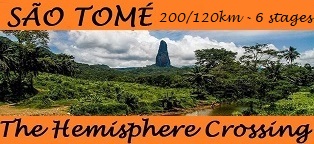Frequent asked Questions to our coach Nathan Montague
1. I've never run more than a half marathon, should/can I still try a multi day stage race?
Absolutely. Specific preparation is vital but it is without doubt possible. Firstly, be prepared to hike. I like to call it hiking with purpose (not just walking). It is not a bad thing and something you have to do because you can’t run no more! It is part of ultra running at all levels and a key skill. Secondly, prepare yourself to be able to fuel on the move. Simply, being able to eat and drink as part of the whole race. Yes, you can stop, but it is always better to eat on the move even if it is hiking. Lastly, the training isn’t too much different from marathon training. Get outside and get time on your feet. Hiking, running, on the trails and back to back runs at the weekends are effective. On a few occasions run twice in a day. It could be a run commute to work. But be prepared to train at obscure times. Time on your feet and on consecuative days.
2. I live in Florida and there's no hill. How to train for a race in the mountains?
We are all limited in some capacity by our environment for the training we need for a specific event. The marathon runner who lives in the mountains or the British runner training in the winter for desert ultra race. It is about being creative and definately approaching challenges in our own environment. Firstly, use the flat for time on your feet but a range of paces is so important so fartlek is crucial in your training as your stride length will be changing all the time. Hit the beach and run up and down the sand. This will increase strength and work the muscles differently. Go on the dry soft sand but also the harder wetter sand near the sea. Keep changing during a run for variety. Do long intervals on the sand too. Hit any kind of trail as often as possible as this will frequently change the way the muscles work as in a trail or mountain race. If there is any kind of hill or slope, be prepared to run loops for long periods of time, broken down with hikes up and runs down. The repeated loop will build resilience which you need. Finally, one of the really great things you can do is print out the the profile of the race onto a clearly visible sheet. Run on the treadmill at a similar gradient to that mountyan pass with that placed in front of you. Visualistaion, resilience and physical conditioing. Run on the flat again straight after to again work the muscles differently. Circuit training (lunges, squats, squat thrusts etc.. ) is vital for muscular endurnace of the legs but also the core. Loaded step ups are also a fantastic tool. Get a backpack loaded with a few books. Build step ups 100, 150, 200 all the way to 500 in one go. Use stairs of buildings or car parks too. Be creative and fun!
3. I am based in Canada where it is freezing cold in winter. However, I plan to run a race in hot and humid areas in November/December. What is your recommendation how to be best prepared?
Your runs outside in the deep cold will build resilience and excellent mental preparation. Not letting the conditions dictate what you aim to do. Train as normal regardless of the weather (obviously safely). For the heat and humidity, scientific evidence suggests you only gain physical benefits from five weeks out. However, it doesn’t hurt to start ealier as there are physchological benefits to be had. Be creative. Beg, borrow or steal a treadmill and set it up somewhere in the house. Whack the heating on, get extra heating in the room and get running and hiking (but safely). If you can’t access a treadmill at home then use a bike on a turbo trainer. Ask your local gym if they can move a bike or treadmill into a little room and get the heating on. Hit the suana straight after a run for 10 mins or so, or go into a hot bath in the same respect. These are especially benefical in the final weeks to help with blood redistribution. Hot yoga is also becoming much more accessible these days.
4. I am a competitive runner and plan my first ever multi-day stage race. What is the best tactic in an ultra/stage race?
Focus on yourself. The main competition you will have is with yourself and controlling the many variables of a multi-stage race. Your nutrition, your pace, your recovery, the conditions, resting and recovering. They are all your priorities before the position you can come. The race can be broken by simple mistakes on any of the above. Treat each day individually, but as part of the jigsaw of the whole race. If people go sprinting off at the start ignore them. Many will not finish or be broke by the second or third day. Do not hit the red. Yes work hard, but ensure you are fuelling all the time and not taking any risks on nutrition or hydration or this will catch up with you the next day. You can run hard but controlled and making sensible decisions.
5. Poles or no poles in technical terrain?
Poles are a magnificent tool to conseve energy on the legs on the uphill and provide excellent controi on technical downhills. However, this is only if you are using them properly and have trained to use them. Without that they can cause more problems than they solve and not provide any benefit. Go on youtube, and search online for tips and masterclasses and practice, practice, practice including putting them away and taking them out quickly.
6. Also about tactic in stage races: steady pace throughout the race or saving energy in the beginning and pace up later?
Both strategies could have the benefit of working. But I believe it is relative to the person and the individual day. Working within yourself is imperative throughout. Good recovery (nutrition and rest) can help hard efforts. Not allowing your pace to be dictated by others is crucial. Run/hike/move hard but within yourself. You shouldn’t be racing in the early days, but only competing against yourself. Go hard but do not hit what we call the red line.
7. Blisters - how to run with lots of blisters on your feet. Is it good idea to bring second pair of shoes?
If you can take a second pair of shoes and not at the sacrifice of something else then yes that might benefit the days where the terrain is very different. However, more importantly good foot care is imperative. Blister prevention should be part of your training and preparation. It is individual. Some people tape their feet especially in hot spot areas. Others, lather their feet in vaseline and although it feels strange, is immensely effective. If you feel a rubbing or hot spot as you are moving, stop and get it sorted straight away. This can often prevent a little rubbing turning into something bigger. Good blister care is also essential so a key part of your preparation should one arise.



